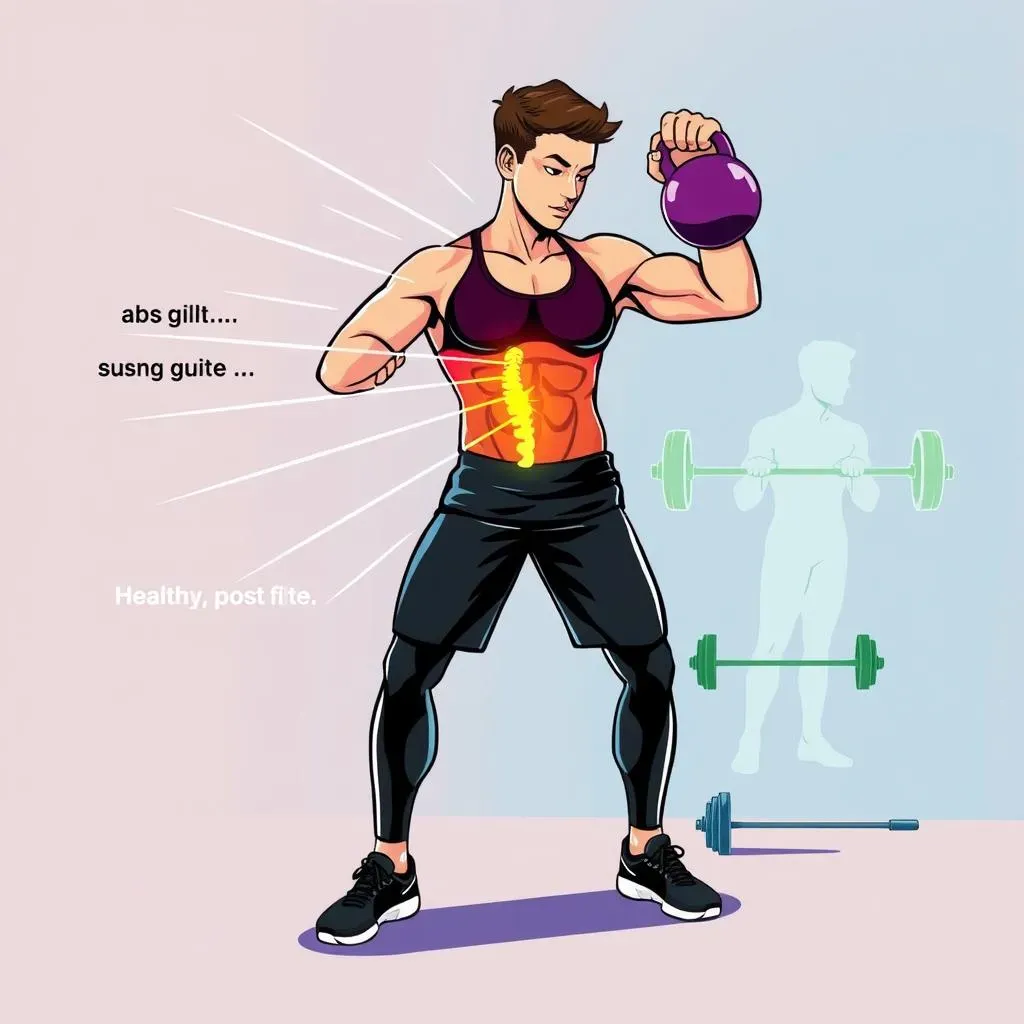Table of Contents
Forget endless crunches! If you're after a core that's not just for show, but built for real-world strength and stability, then it's time to embrace kettlebell core training. Kettlebells aren't just another fitness fad; they're a powerhouse for building a resilient midsection, improving mobility, and ironing out those pesky strength asymmetries we all develop.
Essential Anatomy for Kettlebell Core Training

Essential Anatomy for Kettlebell Core Training
Before we swing into action, let's break down the core players involved in kettlebell core training. You see, your core isn't just your "six-pack" abs; it's a complex network of muscles that work together to stabilize your spine, transfer power, and resist unwanted movement. Understanding these muscles will help you target them effectively with kettlebells and get the most out of every rep.
Think of your core as a 360-degree brace. It's not just about flexing forward; it's about resisting rotation, preventing excessive extension, and maintaining stability under load. When you pick up a kettlebell, especially with unilateral exercises, your core kicks into overdrive to keep you balanced and prevent injury.
Muscle Group | Function | Kettlebell Exercise Example |
|---|---|---|
Rectus Abdominis | Spine flexion, resisting rotation and extension | Unilateral Kettlebell Sit-Up |
Obliques (Internal & External) | Trunk rotation, lateral flexion | Kettlebell Windmill |
Transverse Abdominis | Deep core stability, abdominal compression | Engaged in all kettlebell exercises, especially carries |
Hip Flexors (Iliopsoas, Rectus Femoris) | Hip flexion, stabilize the spine | Kettlebell Dead Bug Pullover |
The rectus abdominis, those "six-pack" muscles, are responsible for flexing your spine, like when you do a crunch. However, their role in kettlebell training is more about resisting extension and rotation, preventing you from bending too far backward or twisting uncontrollably. Then you have the obliques, running along the sides of your torso, are crucial for twisting movements and lateral bending. Kettlebell windmills and suitcase carries are excellent for targeting these muscles.
Top 10 Kettlebell Exercises for a RockSolid Core

Top 10 Kettlebell Exercises for a RockSolid Core
Kettlebell Turkish Get-Up: The Ultimate Core Challenge
The Turkish Get-Up (TGU) isn't just an exercise; it's a full-body symphony of strength, coordination, and control. It smokes your core from start to finish, demanding stability at every stage of the movement. It improves shoulder stability, hip mobility, and overall body awareness. It's a slow, deliberate exercise that forces you to be present and engaged, making it as much a mental challenge as a physical one.
How-to: Start lying on your back with a kettlebell in one hand, arm extended towards the ceiling. Bend the knee on the same side as the kettlebell. Using your core, roll onto your opposite forearm, then to your hand. Bridge your hips up, sweep the straight leg behind you, and kneel. Stand up, maintaining the kettlebell overhead. Reverse the steps to return to the starting position. That's one rep! Aim for quality over quantity.
Double Kettlebell Front Rack Carry: Walking Fortress
Walking with weight might seem simple, but the Double Kettlebell Front Rack Carry is a brutal test of core strength and stability. Holding two kettlebells in the front rack position (at your shoulders) forces your core to work overtime to maintain an upright posture and resist being pulled forward. It's a fantastic exercise for building upper back strength, improving posture, and developing a rock-solid core.
How-to: Clean two kettlebells into the front rack position, resting comfortably at your shoulders. Stand tall with your core engaged, glutes tight, and chest proud. Walk for a designated distance or time, maintaining a stable posture. Avoid leaning back or letting the kettlebells drift forward. If you want to make this even harder, try walking uphill!
Why Kettlebells Trump Traditional Core Workouts

Why Kettlebells Trump Traditional Core Workouts
Off-Balance Advantage: The Instability Factor
Let's face it, traditional core exercises like crunches and planks can become mind-numbingly boring, and their effectiveness plateaus quickly. Kettlebells, on the other hand, introduce an element of instability that forces your core to work harder with every rep. The off-balance nature of the kettlebell challenges your stabilizer muscles in a way that bodyweight exercises simply can't match. Think about it: a plank is static, but a kettlebell swing requires constant adjustments to maintain balance and control.
This instability isn't just about making the exercise harder; it's about recruiting more muscle fibers and developing functional strength that translates to real-world movements. When you're carrying groceries, shoveling snow, or even just walking on uneven terrain, your core needs to be able to react and stabilize. Kettlebell training prepares you for these challenges by building a core that's both strong and adaptable.
Dynamic Lifts: Core Engagement in Motion
Crunches and sit-ups primarily target the rectus abdominis in a limited range of motion. Kettlebells, however, allow for dynamic, multi-planar movements that engage the entire core in a more comprehensive way. Exercises like swings, windmills, and Turkish Get-Ups require your core to stabilize, rotate, and resist movement simultaneously. This dynamic engagement mimics real-life activities and builds a more resilient and functional core.
Imagine the difference between isolating your biceps with a bicep curl versus performing a pull-up. The pull-up engages your entire upper body, including your core, to stabilize and control the movement. Kettlebell exercises are like the pull-ups of core training – they demand full-body integration and build strength that's actually useful.
Stabilizer Muscle Recruitment: Beyond the Six-Pack
While the rectus abdominis gets all the glory, your core is actually composed of many different muscles, including the obliques, transverse abdominis, and even the muscles of your lower back. Kettlebell exercises excel at recruiting these stabilizer muscles, which are essential for maintaining proper posture, preventing injury, and generating power. For instance, a single-arm kettlebell swing not only works your abs but also fires up your obliques to resist rotation and your lower back to maintain spinal stability.
Traditional core exercises often neglect these crucial stabilizer muscles, leading to imbalances and potential injuries. By incorporating kettlebells into your core training, you can build a more balanced and resilient core that's ready to handle whatever life throws your way. It's about building a foundation of strength that supports your body from the inside out.
Benefits Beyond Abs: The Ripple Effect of Kettlebell Core Training

Benefits Beyond Abs: The Ripple Effect of Kettlebell Core Training
so you're hammering away at those kettlebell core exercises, feeling the burn in your abs. That's awesome, but the benefits extend far beyond just a sculpted midsection. Kettlebell core training creates a ripple effect, enhancing your overall fitness and well-being in ways you might not expect. Think of it like this: a strong core is the foundation for everything else you do, both in and out of the gym. It improves your posture, protects your spine, and allows you to move with more power and efficiency.
One of the most significant benefits is improved performance in other lifts. A strong core acts as a stable base for exercises like squats, deadlifts, and overhead presses. When your core is solid, you can transfer force more effectively, allowing you to lift heavier weights and reduce your risk of injury. It's like having a powerful engine in a well-built chassis – everything works better together. The single-arm kettlebell swing, for instance, not only torches your abs but also strengthens your glutes and hamstrings, creating a posterior chain powerhouse.
Sample Kettlebell Core Circuit for Ultimate Strength

Sample Kettlebell Core Circuit for Ultimate Strength
Circuit Design: Intensity and Recovery
Alright, so you're ready to put this kettlebell core training knowledge into action? Let's dive into a killer circuit that'll torch your core and leave you feeling amazing. This isn't just about stringing a few exercises together; it's about strategically combining movements to maximize core engagement and challenge your stability. We're talking about a circuit that'll hit your abs from every angle, forcing them to work overtime to keep you balanced and controlled.
The key to a great kettlebell core circuit is intensity and recovery. You want to push yourself hard during each exercise, but also allow for enough rest to maintain good form throughout the entire circuit. This isn't a race; it's about quality over quantity. Focus on controlled movements, proper breathing, and engaging your core with every rep. Remember, it's better to do fewer reps with perfect form than to rush through and risk injury. Aim for 3-5 rounds of this circuit, resting for 1-2 minutes between rounds.
The Ultimate Kettlebell Core Circuit
Here's the circuit we're going to tackle. Remember to adjust the reps and rest periods based on your fitness level. Don't be afraid to start with fewer reps and gradually increase the volume as you get stronger. Also, listen to your body and take breaks when you need them. This is a challenging circuit, so it's important to pace yourself and avoid pushing yourself too hard, especially when you're just starting out. Let's get to it!
- Kettlebell Turkish Get-Up: 1-2 reps per side
- Double Kettlebell Front Rack Carry: 25-50 feet
- Single-Arm Kettlebell Swing: 10-15 reps per side
- Kettlebell Windmill: 5-8 reps per side
- Unilateral Kettlebell Sit-Up: 8-12 reps per side
Before starting the circuit, warm up with some dynamic stretches and light cardio. After completing the circuit, cool down with some static stretches, holding each stretch for 20-30 seconds. This will help improve your flexibility and reduce muscle soreness. Also, remember to stay hydrated by drinking plenty of water before, during, and after your workout. Proper hydration is essential for optimal performance and recovery.
Unleash Your Core Potential with Kettlebell Core Training
So, ditch the endless sit-ups and embrace the dynamic power of kettlebell core training. By incorporating these 10 exercises into your routine, you're not just building a six-pack; you're forging a stronger, more stable, and more functional core that will enhance every aspect of your fitness journey. Remember to focus on proper form, progressive overload, and listen to your body. With consistent effort and the right kettlebell, you'll unlock a level of core strength and stability you never thought possible. Now go forth and conquer!